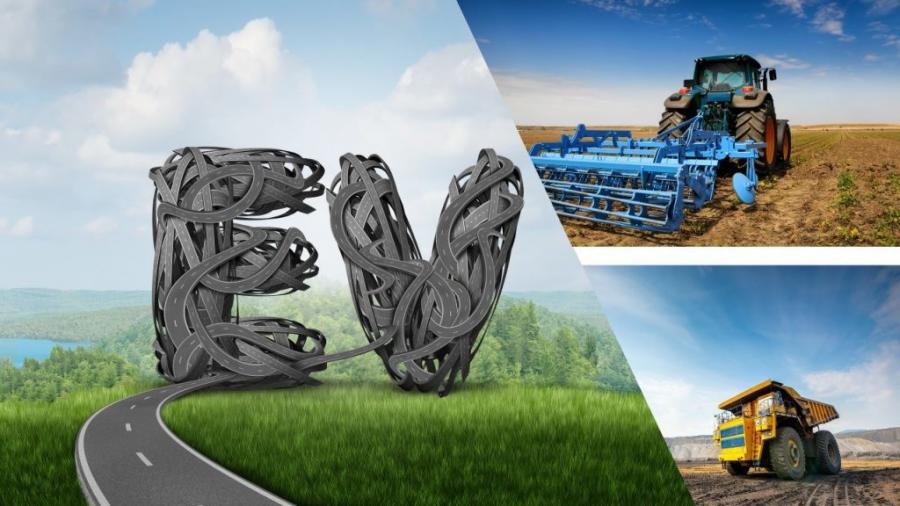
Wed March 10, 2021
Alastair Hayfield, Interact Analysis
As global economies continue to reel from the effect of the COVID-19 pandemic, the vaccine roll-out gives reason for optimism. The talk now is of economies bouncing back after a poor 2019 and a catastrophic 2020.
In its latest report on off-highway vehicles, Interact Analysis predicts a scenario where pent-up demand will be a driver for significant growth in the sector, as economic wheels get back on track.
While growth sunk to a mere 2.6 percent in 2020, Interact Analysis's research predicts 6.5 percent growth in 2021, and an overall CAGR of 3.6 percent up to 2029. Furthermore, electrification of certain classes of off-highway vehicles is expected to continue at a rapid pace.
Off-Highway Vehicles and the COVID-19 Effect
Not even the virus has stopped the unprecedented modernization and extension of China's infrastructure network. The figures in the table below tell the story:

While the figures in red describe tumbling growth in 2020 for many different machinery types across most of the globe as countries battled with the virus and production slowed or shut down, in China things stabilized quite quickly, as rigorous measures to combat the virus were enforced.
Production got back to normal by May 2020, and demand for off-highway equipment resumed. Aerial work platforms saw a massive 74 percent hike in sales, telehandlers more than 40 percent and excavators more than 37 percent.
2021 – The Year of the Great Bounce Back
While China has mitigated the overall impact of the pandemic on the global off-highway vehicle market, 2020 was undeniably a shocker for the industry, but it's an industry poised to make a comeback, with material handling equipment leading the field by 2025, when sales are forecast to surpass those of agricultural machinery. (Agricultural machinery has not previously been included in the scope of the off-highway vehicles report.)
2019/20 saw a slowdown in sales of material handling equipment, but the surge in online shopping and eCommerce caused by the virus is likely to be a significant long-term driver for investment in machinery such as lift trucks, particularly as new warehouse automation projects come on stream.
Interact Analysis has detected the likelihood of future healthy demand from SMEs and forecasts a return to double-digit growth rates by 2022, with sales of approximately 2.4 million units by 2023. All this, of course, rides on the battle with the virus.
Overall unit shipments for the construction segment decreased by 2.5 percent in 2020, due to the impact of COVID-19, giving a growth rate of minus 2 percent. But sales of construction vehicles in China sustained solid growth of 26.6 percent, otherwise the global figures would have been far worse.
The size of the Chinese market in 2020 was close to 400,000 units and it was the largest regional market, accounting for 43 percent of the global sales in terms of unit shipments.
The global construction vehicle market will reach its cyclical peak in 2021, having achieved a growth rate of 8 percent. Thereafter, up to 2029, the growth rate is forecast to be of the order of between 2 and 4 percentage points year on year.
Excavators are the largest product group in the construction segment, accounting for more than 50 percent of units shipped in major regional markets such as North America, Europe, and China.
Electrification — Drivers and Barriers
The research shows that more than 36 percent of shipments of off-highway vehicles will be electrified machinery by 2029. However, the overwhelming majority of these will be smaller machines. Research shows that there are good reasons for using BEV technology in larger construction vehicles, such as lower TCO and environmental concerns; but there are also significant barriers, such as upfront costs, lack of charging infrastructure and charging downtime.
Electrification of compact construction vehicles offers many obvious benefits, minimizing emissions and noise levels, allowing the equipment to be used in enclosed environments such as in mines, buildings and in other noise-sensitive areas.
For many of the environments where material handling typically works, such as airports and logistics centres, there is already a high demand for "greener" equipment. These places will continue to adopt electrification aggressively.
For more information, visit www.interactanalysis.com.
This story also appears on Construction Equipment Guide.
 Aggregate Equipment
Aggregate Equipment Articles
Articles Email Updates
Email Updates Sell Your Machines
Sell Your Machines

 Aggregate Equipment
Aggregate Equipment Aggregate Dealers
Aggregate Dealers Aggregate Articles
Aggregate Articles Email Updates
Email Updates Sell Your Machines
Sell Your Machines